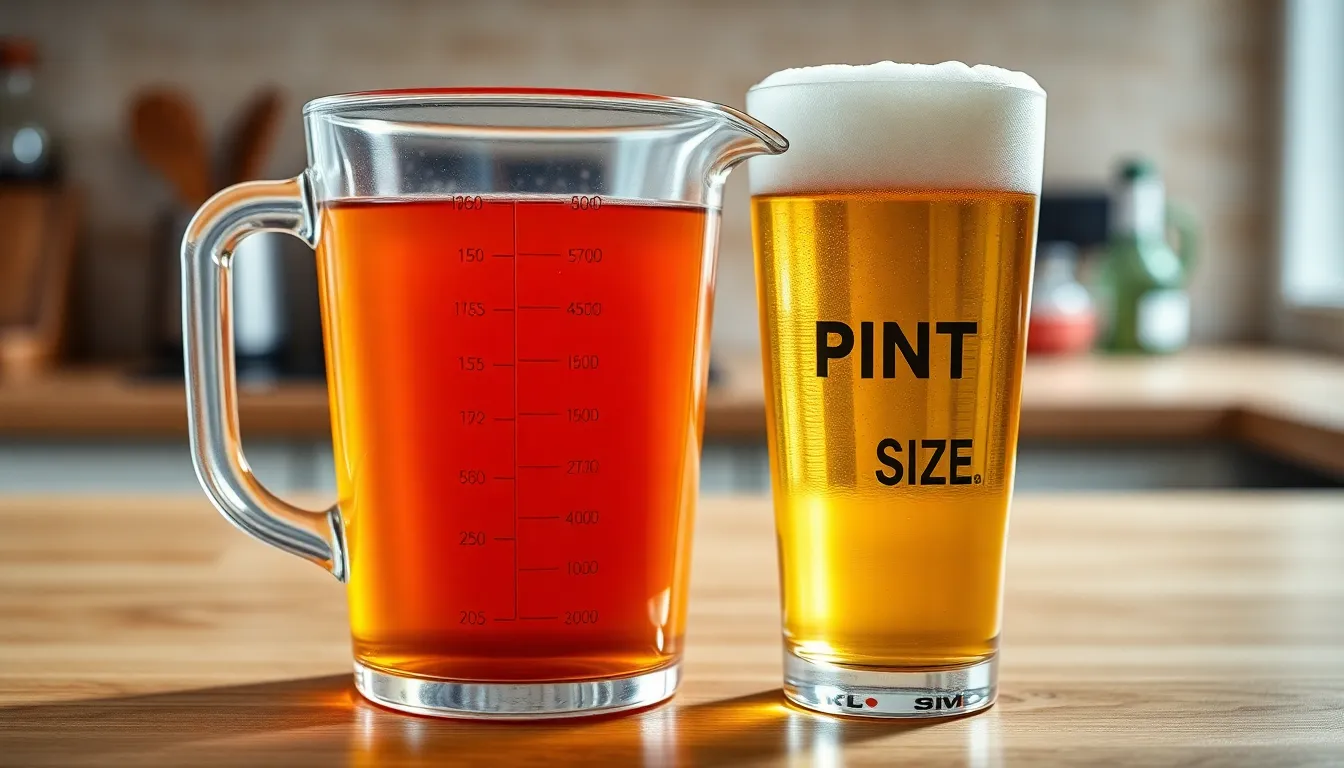Table of Contents
ToggleWhen it comes to cooking and baking, understanding measurements is crucial. Many home cooks and bakers often find themselves puzzled by the relationship between different units. One common question that arises is whether one pint equals two cups.
This seemingly simple inquiry can lead to confusion, especially for those new to the culinary world. Knowing the correct conversions not only helps in following recipes accurately but also enhances the overall cooking experience. In this article, we’ll explore the answer to this question and provide clarity on pint and cup measurements, ensuring that every dish turns out just right.
Understanding Pints and Cups
Understanding the relationship between pints and cups simplifies cooking and baking. A pint measures volume in both the United States and the United Kingdom, but these measurements differ slightly.
In the United States, one pint equals two cups. This metric makes conversions straightforward for recipes that include pint measurements.
| Measurement | U.S. Equivalent |
|---|---|
| 1 Pint | 2 Cups |
| 1 Cup | 8 Fluid Ounces |
| 1 Pint (UK) | 2.4 Cups (approx.) |
For easier recipe adjustments, knowing this conversion enables cooks to gauge ingredient quantities efficiently. When using other measurement systems, cooks should remain aware that a pint in the U.K. contains more fluid than a U.S. pint.
The Definition of a Pint

A pint serves as a unit of volume measurement, widely used in both liquid and dry contexts. In the U.S., one pint equals 2 cups, making it simple for recipe conversions.
Different Types of Pints
Pints vary slightly based on the measurement system employed.
- U.S. Pint: A U.S. pint measures 16 fluid ounces, which is equivalent to 2 cups. It’s the standard for most liquid measurements in American cooking.
- U.K. Pint: A U.K. pint measures approximately 20 fluid ounces, translating to about 2.4 cups. This variation can lead to confusion, especially in recipes sourced from different countries.
- Imperial Pint: The Imperial pint, like the U.K. pint, is used primarily in the U.K. and some other Commonwealth nations. Its size further emphasizes the differences in volume measurement across regions.
Understanding these distinctions enhances clarity when following recipes from various sources.
The Definition of a Cup
A cup serves as a standard unit of measurement in cooking and baking, providing consistency in ingredient quantities. Understanding its definition is crucial for accurate recipe preparation.
Standard Cup Measurement
A standard cup in the U.S. measures 8 fluid ounces. This unit of volume applies primarily to liquid ingredients such as water, milk, and oil, though it can also apply to dry ingredients like flour and sugar. Recipes commonly refer to the cup measurement for both practical and convenience purposes. For clarity, measuring cups come in sets, typically labeled with their respective capacities, ensuring precise portions are used. This standardization aids both novice and experienced cooks in achieving desired outcomes across various culinary applications.
The Conversion Between Pints and Cups
Understanding the conversion between pints and cups is essential for accurate recipe preparation. This section explains the mathematical relationship and practical applications.
Mathematical Explanation
One pint equates to two cups in the United States. This conversion is simple, as one U.S. pint equals 16 fluid ounces. Conversely, one U.S. cup is 8 fluid ounces. The equation can be represented as follows:
| Measurement | Fluid Ounces |
|---|---|
| 1 Pint | 16 |
| 1 Cup | 8 |
To verify the conversion mathematically:
- 1 Pint (16 fluid ounces) ÷ 8 fluid ounces (1 cup) = 2 Cups
This relationship holds for both liquid and dry ingredients within U.S. measurement standards. In contrast, in the U.K., one pint equals approximately 20 fluid ounces, which translates to about 2.4 cups. Thus, for precise measurements, it’s important to distinguish between U.S. and U.K. pints.
Practical Applications
Applying this conversion in the kitchen enhances recipe accuracy. Recipes often list ingredients in pints or cups, making knowledge of conversions valuable. For instance, when a recipe calls for 1 pint of broth, knowing this equals 2 cups allows cooks to measure accurately.
Moreover, it aids in adapting recipes. If a recipe calls for 4 cups of liquid, understanding it translates to 2 pints simplifies adjustment processes. This reinforces the importance of grasping these conversions, especially when cooking from various sources or in different countries. Accurate measurements prevent mishaps in flavor and texture, ensuring overall culinary success.
Common Misconceptions
Many misconceptions surround the conversion of pints to cups. One prevalent misunderstanding suggests that a pint differs in measurement between recipes. A U.S. pint always equals two cups, regardless of the recipe source.
Another misconception claims that all pints are the same globally. While the U.S. pint measures 16 fluid ounces (2 cups), the U.K. pint measures about 20 fluid ounces (approximately 2.4 cups). This difference can lead to confusion when using international recipes.
Some cooks believe that a cup measurement can vary based on the ingredient. While it’s true that ingredient density affects weight, a standard U.S. cup uniformly measures 8 fluid ounces for both liquids and dry ingredients.
Lastly, there’s a notion that only experienced cooks can accurately convert measurements. Anyone can grasp these simple conversions, facilitating a better cooking experience. Understanding these distinctions helps prevent miscalculations and ensures recipe success.
Understanding the relationship between pints and cups is essential for anyone who enjoys cooking or baking. Knowing that one U.S. pint equals two cups simplifies recipe conversions and helps prevent errors in measurements. This clarity is particularly beneficial for novice cooks who may find themselves navigating various recipes.
By grasping these fundamental measurements, cooks can confidently follow instructions and achieve the desired results. Whether preparing a favorite dish or experimenting with new ingredients, accurate measurements enhance the overall culinary experience. Embracing these conversions can lead to successful cooking adventures and delicious outcomes.



